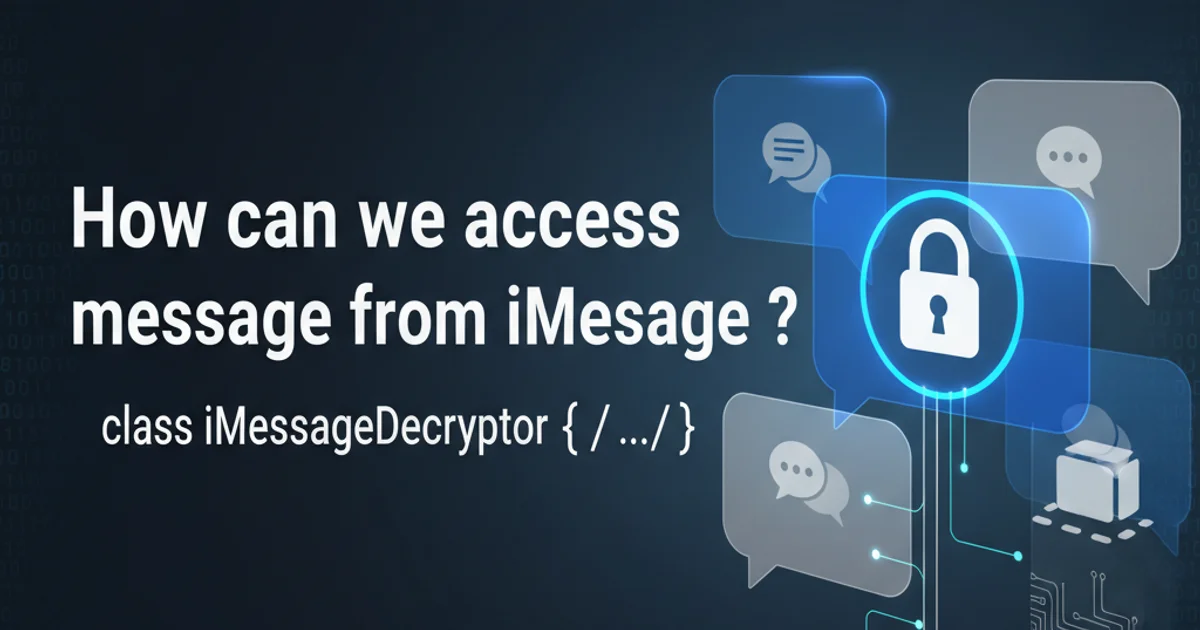How can we access message from iMessage ?
Categories:
Accessing iMessage Data: Challenges and Possibilities

Explore the technical hurdles and potential methods for programmatically accessing messages from Apple's iMessage service, focusing on security, privacy, and developer limitations.
iMessage, Apple's proprietary instant messaging service, is deeply integrated into the iOS ecosystem, offering end-to-end encryption and a seamless user experience. For developers and users alike, the idea of programmatically accessing iMessage data – whether for backup, analysis, or integration with other services – is often appealing. However, due to Apple's stringent security and privacy policies, direct access to iMessage content is highly restricted. This article delves into why direct access is challenging and explores the limited avenues that might exist, along with their associated complexities and ethical considerations.
Understanding Apple's Security and Privacy Model
Apple prioritizes user privacy and data security above all else. iMessage conversations are end-to-end encrypted, meaning only the sender and intended recipient can read the messages. This design choice inherently prevents third-party applications or even Apple itself from easily accessing message content. The data is stored in a secure container on the device, and access is tightly controlled by the operating system.
flowchart TD
A[User Sends iMessage] --> B{iMessage Server}
B --> C{Recipient Device}
C -- Encrypted --> D[Secure Storage on Device]
D -- No Direct API Access --> E[Third-Party App]
style E fill:#f9f,stroke:#333,stroke-width:2pxSimplified iMessage Data Flow and Access Restrictions
Official and Unofficial Avenues for Access
While direct programmatic access to iMessage content is not officially supported, there are a few indirect methods or considerations that developers might explore, each with significant limitations.
1. Messages Framework (iOS 10+)
The Messages framework, introduced in iOS 10, allows developers to create iMessage apps that run within the Messages app itself. These apps can send and receive MSMessage objects, which can contain text, stickers, media, and custom data. However, this framework is designed for extending iMessage functionality, not for reading existing conversations. An iMessage app can only access messages that it itself sends or receives, or messages that a user explicitly shares with it. It cannot read the user's entire message history.
import Messages
class MessagesViewController: MSMessagesAppViewController {
override func didSelect(_ message: MSMessage, conversation: MSConversation) {
// This method is called when the user selects a message sent by your app.
// You can access the message's content here.
if let url = message.url {
print("Selected message URL: \(url)")
}
if let layout = message.layout as? MSMessageTemplateLayout {
print("Selected message caption: \(layout.caption ?? "")")
}
}
override func didStartReceiving(_ conversation: MSConversation) {
// Called when the extension is activated.
// You can access the active conversation, but not its history.
print("Active conversation identifier: \(conversation.selectedMessage?.identifier ?? "")")
}
}
Example of accessing an MSMessage within an iMessage app extension.
2. macOS Database Access (Limited and Complex)
On macOS, iMessage data is stored in a SQLite database, typically located at ~/Library/Messages/chat.db. While this database contains message content, attachments, and participant information, directly accessing and parsing it comes with several caveats:
- Permissions: Accessing this file requires appropriate user permissions.
- Database Schema: The schema can change with macOS updates, making parsing logic fragile.
- Encryption: While the database itself isn't end-to-end encrypted in the same way as the messages in transit, certain sensitive data might be protected by macOS's data protection mechanisms.
- Ethical Concerns: Building tools that scrape this database without explicit user consent raises significant privacy and ethical questions.
-- Example SQL query to inspect the chat.db on macOS
-- This is for illustrative purposes only and requires direct file access.
SELECT
message.text,
datetime(message.date + 978307200, 'unixepoch', 'localtime') AS message_date,
handle.id AS sender
FROM
message
LEFT JOIN
handle ON message.handle_id = handle.ROWID
ORDER BY
message.date DESC
LIMIT 10;
Illustrative SQL query for chat.db on macOS. Requires direct file access and understanding of schema.
3. iCloud Backups (Indirect and Not Programmatic)
iMessage conversations can be backed up to iCloud. While this provides a way to restore messages to a new device, it does not offer programmatic access to the message content for third-party applications. Extracting data from iCloud backups is a complex process, often requiring specialized forensic tools, and is not part of any public developer API.
Why Direct Access is Unlikely to Change
Apple's commitment to user privacy is a core tenet of its brand. Allowing direct, programmatic access to iMessage content would fundamentally undermine the end-to-end encryption and secure messaging experience that users expect. Such a feature would open doors to potential surveillance, data breaches, and misuse of personal communications, which Apple has consistently worked to prevent. Therefore, it's highly improbable that Apple will introduce APIs for direct iMessage content access in the foreseeable future.